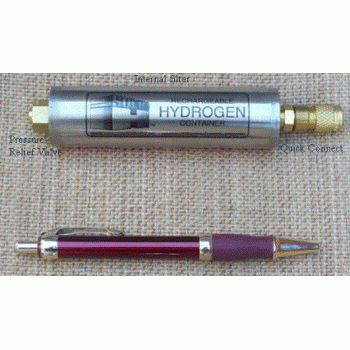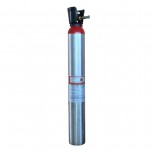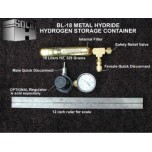BL-20 Metal Hydride
Recommended Accessories:
The BL-20 metal hydride has a Hydrogen Capacity of 20-21 standard liters (0.76-0.80 scf) and a recharge time of about 4 hours.
About Solid-H Hydrides
SOLID-H hydrogen storage containers are filled with metal powders that absorb and release hydrogen (metal hydrides). You may already be using metal hydrides in your laptop computer (nickel-metal hydride batteries).
The most popular SOLID-H containers supply a few atmospheres of hydrogen gas pressure at room temperature. This is the safest method known for storing flammable hydrogen gas. If your hydrogen system develops a leak, SOLID-H immediately releases a small fraction of its stored hydrogen. The remainder will be released over a period of hours.
Typical uses for SOLID-H include hydrogen supplies for gas chromatographs and fuel storage for hydrogen engines or fuel cells.
Alloy Choices
If you want to see a pressure-composition isotherm and a pressure-temperature Van't Hoff plot for each alloy click here for Alloy A or here for Alloys L, M, H. Alloy A contains iron and titanium while Alloys L, M and H contain rare earth metals and nickel. Alloy A is less expensive than Alloys L, M or H. This makes no difference in prices of smaller containers because assembly labor cost dominates production costs. Larger containers, cost extra mostly due to the higher alloy costs.
Ordering
The prefix of the part number indicates the container material. BL indicates a stainless steel container, except the BL-18, which is carbon steel. CL indicates an aluminum industrial gas cylinder. Standard quick connects and relief valves are made of brass. The part number specifies the hydrogen capacity in “standard” liters (1 atmosphere absolute pressure at 0°C). CL-400A means 400 standard liters of hydrogen capacity from Alloy A, the standard alloy for this container. The alloy choice is added to the part number, for example BL-30M or CL-400A. Contact us if you have any questions or concerns before placing your order.
All hydrogen containers ship empty.
| Metal Hydride Properties | |
| Hydrogen Capacity - Alloy A | 21 standard liters (0.80 scf) |
| Hydrogen Capacity - Alloys L, M, or H | 20 standard liters (0.76 scf) |
| Hydrogen Pressure when Charging or Discharging | Alloy A, Alloy H, Alloy L, and Alloy M hydrides require the hydrogen charging pressure of 400 psig, 400 psig, 100 psig, and 200 psig, respectively. The discharging pressure during the discharge cycle would be very similar to the respective charging pressure of the selected hydride (assuming that stored hydrogen gas is not vented instantaneously). The SOLID-H™ container will become hot to the touch as it absorbs hydrogen (during charging stage). Charging is complete when it has cooled to room temperature. |
| Discharge Rate | The discharge rate depends on many variables. We can help you select a SOLID-H™ metal hydride alloy and hydrogen container(s) that will meet your hydrogen flow requirements. In general, you should not expect to empty the entire hydrogen capacity in a matter of minutes. Hours are required to withdraw 90% or more of the hydrogen capacity from a standard** metal hydride container. The largest SOLID-H™ containers require days to discharge completely. **It is possible to discharge a metal hydride in a matter of seconds. This requires extraordinary heat transfer enhancement inside and outside of the container. We can provide heat transfer enhancement to improve the charging and discharging rates of our SOLID-H™ containers. |
| Recharge Time | ~4 hours - The specified recharge time is for cooling by still air at 20℃ and the charging pressure specified in the SOLID-H™ manual for Alloys A, L, M or H. A fan will shorten charging time. |
| Cylinder Diameter | 1.125 inch (28.6 mm) |
| Overall Length | 5.8 inch (147 mm) |
| Mass | 0.68 lb (307 grams) |
| Destructive Proof Test | >5000 psig (476 bar) |
| Pressure Relief Valve Set | <550 psig (37 bar) |
| Materials Included | Stainless Steel Cylinder with Brass Fittings |
Write a review
Your Name:
Your Review: Note: HTML is not translated!
Rating: Bad Good
Enter the code in the box below:






































